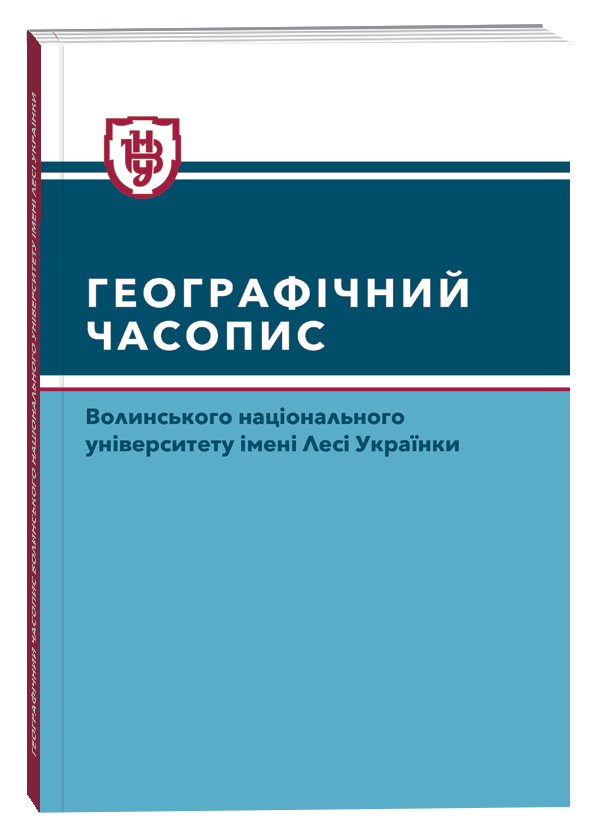SUBSTANTIATION OF MEASURES OF RATIONAL USE AND PROTECTION OF SACRAL SPRINGS
DOI:
https://doi.org/10.32782/geochasvnu.2023.2.02Keywords:
sacral spring, function, landscape-sacral tourist attraction, measures for the protection and preservation of sacral springsAbstract
The purpose of the article is to develop and substantiate measures of rational use and protection of sacral water springs. The work uses a transdisciplinary approach, which provides scientific search within the sacral landscape science using methodological and methodological approaches of other disciplines, as well as methods: structural-logical generalization and systematic analysis, induction and deduction, generalization of scientific sources. The scientific novelty of the study is that the first to formulate the term landscape-sacral tourist attraction (natural or natural-anthropogenic complex, which has a special scientific, historical, cultural, aesthetic and cognitive significance as spring, cave, rock, etc.) and the expediency of introducing this type of monuments into the nature reserve fund of Ukraine is substantiated. System classification of functions of sacral springs was carried out. Their division into two groups is substantiated: social (providing drinking needs, tourist and recreational appeal, providing spiritual needs, historical and cultural, therapeutic), natural (hydrological, hydrogeological, ecological). The analysis of regulatory documents that ensure the protection and preservation of sacral springs was carried out. The vast majority of sacral springs do not have the status of security objects/territories, which certifies the need to improve the legal basis for their functioning. A system of leading measures of rational use and protection of sacred springs, which can be used at regional and state levels, has been developed.
References
Водний кодекс України. URL: https://zakon.rada.gov.ua/laws/show/213/95-%D0%B2% D1%80#Text (дата звернення: 22.07.2022)
Закон України «Про охорону навколишнього середовища». URL: https://zakon.rada.gov.ua/l aws/show/1264-12#Text (дата звернення: 22.07.2022)
Карта джерел у Львові та околицях на випадок відсутності води. Zaxid.net. URL: https://zaxid.net/karta_dzherel_u_lvovi_ta_okolitsyah_na_ vipadok_ vidsutnosti_vodi_n1536713 (дата звернення: 22.07.2022)
Кліматогенні зміни рослинного світу Українських Карпат / наук. ред. Я. П. Дідух, І. І. Чорней. Чернівці : Друк Арт, 2016. 280 с.
Корчемлюк М. В., Кравчинський Р. Л, Стефурак О. М. Роль карпатських природних джерел в житті і побуті гуцулів // Гуцульщина – ХХІ сторіччя : проблеми та перспективи збереження гірської природи та етнічної культури в гуцульському регіоні Українських Карпат в умовах глобалізації : матеріали. наук.-практ. конф. (м. Яремче, 27 липня 2018 р.). Яремче, 2018. С. 173‒175.
Кравчинський Р. Л., Хільчевський В. К., Корчемлюк М. В., Стефурак О. М. Моніторинг природних водних джерел Карпатського національного природного парку / за ред. В. К. Хільчевського. Івано-Франківськ : Фоліант. 2019. 124 с.
Міщенко О. В. Водні джерела Волинської області в структурі сакрального ландшафту. Вісник Київського національного університету імені Тараса Шевченка. Серія : Географія. Вип. 3 (72). К. : ВПЦ «Київський університет», 2018. С. 88‒93. DOI: http://doi.org/10.17721/1728-2721.2018.72.15.
Міщенко О. В., Фенко В. О. Водні джерела Волинської області : класифікація та просторове розташування. Вісник Київського національного університету імені Тараса Шевченка. Серія : Географія. Вип. 3 (80). К. : ВПЦ «Київський університет», 2021. С. 36‒40.
Петлін В. М., Міщенко О. В. Сакральні джерела Львівської області в структурі ландшафтів. Наукові записки Тернопільського національного педагогічного університету імені Володимира Гнатюка. Серія : географія. Тернопіль : СМП «Тайп». 2022. № 2. Вип. 53. С. 107–113.
Про природно-заповідний фонд України : Закон України. Відомості. Верховної Ради України. 1992. № 34.
Amiel R., Grodek T., Frumkin A. Characterization of the hydrogeology of the sacred Gihon Spring, Jerusalem : A deteriorating urban karst spring. Hydrogeology Journal. 2010. Vol. 18. No 6. P. 1465‒1479.
Bascik M., Chełmicki W. Zrodła. Przyroda, geografia, mistyka. Kołtuniak J. (red.) Rzeki. Kultura, cywilizacja, historia. T. 11, Katowice, 2002, Р. 119‒144.
Bascik M., Chelmicki W. The Spring as an object of interdisciplinary research. B. Izmailow (Eds.), Nature, Humans, God. Krakow : Institute of Geography and Spatial Management, Jagiellonian University. 2004. P. 149–170.
Depalmas A. Water and cults in nuragic Sardinia. Wiley Interdisciplinary Reviews. Water. 2018. Vol. 5, No 5, e1293. DOI: https://doi.org/10.1002/wat2.1293.
Dingwall P., Weighell T., Badman T. Geological World Heritage : A global framework, A Contribution to the Global Theme Study of World Heritage Natural Sites, IUCN, 2005. 51 p.
Haland E. J. Water sources and the sacred in modern and ancient greece and beyond. Water History, 2009. Vol. 1, No 2. 83‒108. URL: https://login.research4life.org/tacsgr1doi_ org/10.1007/s12685-009-0008-1
Jokiel P., Michalczyk Z. Studies on, the Use and Protection of Springs in Poland. Management of Water Resources in Poland. 2021. P. 113‒139. DOI: https://doi.org/10.1007/978-3-030-61965-7_7.
Klempe H. Te hydrogeological and cultural background for two sacred springs, Bø, Telemark County, Norway. Quaternary International. 2015. Vol. 368. P. 31–42. DOI: https://doi.org/10.1016/j.quaint.2014.10.048.
Mishchenko O. V. Structural organization of sacred landscapes. Journal of Geology, Geography and Geoecology, 2019. 28 (3), P. 487‒494. DOI: http://doi: 10.15421/111944
Ray C. (Eds.). Sacred waters : A cross-cultural compendium of hallowed springs and holy wells. New York, Abingdon : Routledge, 2020. URL: https://www.routledge.com/Sacred-Waters-A-Cross-Cultural-Compendium-of-Hallowed-Springs-and-Holy/Ray/p/book/9780367445133l. [17 July 2022].







